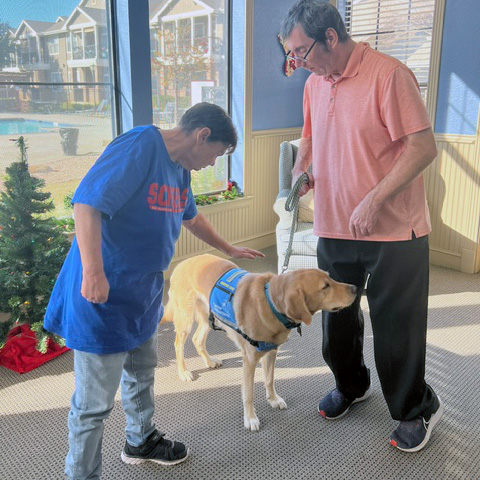Know Your Service Dog Etiquette
As a service dog handler, myself, I understand the importance of maintaining a clear boundary when it comes to interactions with these specially trained companions.
However, can your friend pet your service dog? No, it’s generally not advisable. Service dogs are highly trained and focused on assisting their handlers with specific tasks related to disabilities. Distractions, like petting, can disrupt their concentration and hinder their ability to perform crucial tasks.
While the answer seems straightforward, there are many important factors to consider. Understanding the reasons behind this guideline and its potential impact on service dogs and their handlers can clarify maintaining appropriate boundaries. Let’s see the exciting parts of all these.
Why Can’t Your Friend Pet Your Service Dog?
These amazing animals are not just pets but are highly trained to perform thorough tasks that help their handlers with various disabilities. Let me disclose the major reasons why it’s essential to avoid petting service dogs and respecting their working environment.
1. Focused on the Task at Hand: When a service dog is in its working mode, their attention needs to be undivided. They are trained to be hyper-attentive to their handler’s needs and respond promptly to specific commands. Petting the dog can be a major distraction, making it challenging for them to focus on their tasks effectively.
2. Safety First: Service dogs are not only companions but essential aids for individuals with disabilities. Distracting them can compromise their ability to keep their handlers safe in various situations. Whether it’s guiding a visually impaired person across the street or alerting someone with epilepsy before a seizure, their concentration is critical to ensure the safety and well-being of their handlers.
3. Confusion and Stress: Imagine trying to concentrate on a complex task while someone constantly interrupts you. It can be incredibly frustrating and disorienting. The same applies to service dogs. When they are approached and petted by strangers, it can lead to disorder and stress, as they are unsure whether to focus on their task or engage with the person.
4. Maintaining Boundaries: Training service dogs takes time, effort, and dedication. Maintaining boundaries is essential to reinforce their understanding of when they are in work mode and when they can relax. Allowing others to pet them can blur these lines and make it harder for them to differentiate between work and leisure time.
5. Legal Implications: In many regions, there are laws protecting the rights of service dog handlers. Interfering with the working ability of a service dog, including petting them without permission, can be considered a violation of these laws. Understanding and respecting service dog etiquette ensures its effectiveness and helps us comply with legal requirements.
6. Bond with the Handler: Service dogs share an incredible bond with their handlers. They are not just assistants; they are loyal companions who also provide emotional support. Petting them without permission can create unnecessary distance between the dog and its handler, impacting the trust and communication that are crucial in their partnership.
7. Training Reinforcement: By respecting the rules and not petting service dogs without permission, we reinforce their training and support their continued effectiveness as service animals. Consistent boundaries help these wonderful animals maintain their top-notch skills, making a positive difference in their handlers’ lives.
What to Do If Someone Insists on Petting Your Service Dog
As a service dog handler, I understand how challenging it can be when someone insists on petting your service dog. While it may come from a place of good intentions, educating others about the importance of respecting a service dog’s working role is essential. Here are some steps you can take if someone insists on petting your service dog:
Educate and Explain: Take the opportunity to educate the person about the role of service dogs and why it’s essential not to pet them while they are working. Politely explain that your service dog requires full focus to assist you effectively.
Use Clear Commands: Train your service dog to respond to commands like “ignore” or “leave it.” If someone approaches without permission, use these commands to redirect your dog’s attention back to you.
Be Firm but Kind: If the person persists after your explanation, be firm but kind in reiterating that petting your service dog is not allowed while they are working. Emphasize that it’s for the safety and well-being of both the dog and its handler.
Advocate for Yourself: As a service dog handler, you have rights protected by law. If the person’s insistence becomes problematic, don’t hesitate to assert your rights calmly and respectfully.
Share Your Experience: Sometimes, sharing personal experiences can significantly impact you. Explain how your service dog has positively impacted your life and how important it is to maintain their focus during their working hours.
Addressing Common Misconceptions and Myths about Service Dogs
Being a service dog handler, I have encountered numerous misconceptions and myths surrounding these incredible animals. As they play a crucial role in assisting individuals with disabilities, it’s essential to debunk these misunderstandings and provide a clearer understanding of their invaluable service. Let’s shed light on some of these common misconceptions and myths about service dogs to foster greater empathy and respect for their societal role.
Misconception 1: All Dogs Can Be Service Dogs
One of the most widespread misconceptions is that any well-behaved dog can be a service dog. In reality, service dogs undergo specialized training tailored to the specific needs of their handlers. This rigorous training ensures they can perform precise tasks that help individuals with disabilities lead more independent lives. Not every dog has the temperament, intelligence, and focus required for this level of training.
Misconception 2: Service Dogs Are Only for the Blind
While guide dogs indeed assist individuals with visual impairments, service dogs are trained to support individuals with a wide range of disabilities. These can include hearing impairments, mobility challenges, seizure disorders, psychiatric conditions, and more. Each service dog’s training is designed to meet the unique needs of their handler, making them indispensable companions in various contexts.
Misconception 3: You Can Interact and Pet Service Dogs Anytime
A common misconception is that service dogs are like regular pets and enjoy attention from everyone. On the contrary, when service dogs are in their working mode, it’s essential not to interact with them unless given explicit permission by their handler. Unsolicited attention, such as petting, can distract them from their responsibilities, potentially risking their own safety and handler’s safety.
Misconception 4: Service Dogs Don’t Need Rest or Breaks
Service dogs work diligently to assist their handlers but also need adequate rest and breaks to stay healthy and focused. Working tirelessly without breaks can lead to physical and mental exhaustion, hindering their ability to perform their duties effectively. Responsible service dog handlers ensure their companions have sufficient rest time.
Misconception 5: Emotional Support Animals (ESAs) Are the Same as Service Dogs
While both emotional support animals (ESAs) and service dogs offer valuable emotional support, they serve different roles. Service dogs are particularly trained to execute tasks that mitigate their handler’s disabilities. In contrast, ESAs provide comfort and companionship to individuals with emotional or psychological conditions but are not trained to perform specific tasks.
Misconception 6: Service Dogs Are Always Wearing Vests or Identifying Gear
While many service dogs wear vests or identifying gear to signal their working status, it’s not a universal requirement. In some regions, service dog owners may choose not to use identifying gear, but this doesn’t diminish their dog’s role or rights. Respecting all service dogs, regardless of whether they wear identifying gear, is essential.
Misconception 7: You Can Buy Fake Service Dog Gear Online
Unfortunately, some individuals attempt to pass off their pets as service dogs by purchasing fake service dog gear online. This dishonest practice undermines the credibility and legitimacy of genuine service dogs. It is important to remember that only properly trained service dogs are granted the privileges and access afforded to them by law.
Conclusion: So, addressing these common misconceptions and myths about service dogs is crucial for promoting a more understanding and inclusive society. And also, it is essential to respect their training, purpose, and the rights of their handlers. By dispelling these misconceptions, we can ensure that service dogs receive the appreciation and consideration they deserve while providing invaluable support to those in need.
Now that you’ve learned about the importance of why you can’t pet your friend’s service dog, help spread the word. Tell your friends and family what you’ve learned by reading this post. And share this post on your social media platforms.




